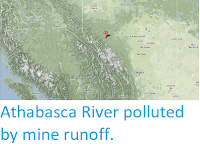An ice-climber has been injured in an avalanche in Clearwater County in Alberta, Canada, on Saturday 10 March 2018. The as yet unnamed man was one of a party of four people who were ice climbing on the Kitty Hawk ice climbing route on Mount Elliot, near Noregg, when they were hit by the avalanche, in which he received injuries to his leg. All four members of the party were able to walk off the mountain to a nearby highway, where they were met by emergency services and the injured man airlifted to hospital.
The approximate location of the 10 March 2018 Mount Elliot avalanche. Google Maps.
Avalanches are caused by the mechanical failure of snowpacks;
essentially when the weight of the snow above a certain point exceeds
the carrying capacity of the snow at that point to support its weight.
This can happen for two reasons, because more snow falls upslope,
causing the weight to rise, or because snow begins to melt downslope,
causing the carrying capacity to fall. Avalanches may also be triggered
by other events, such as Earthquakes or rockfalls. Contrary to what is
often seen in films and on television, avalanches are not usually
triggered by loud noises. Because snow forms layers, with each layer
typically occurring due to a different snowfall, and having different
physical properties, multiple avalanches can occur at the same spot,
with the failure of a weaker layer losing to the loss of the snow above
it, but other layers below left in place - to potentially fail later.
Diagrammatic representation of an avalanche, showing how layering of snow contributes to these events. Expedition Earth.
Northwestern North America have seen a number of
avalanche related incidents this winter,
largely due to high levels of snowfall. This is, in turn caused by
warmer conditions over the Pacific, which leads to higher rates of
evaporation over the ocean, and therefore higher rates of precipitation
over North America, which falls as snow in cooler upland regions. There
are further concerns that as the climate warms in the coming months, the
thawing of this snow will lead to further dangerous avalanches.
See also...
Follow Sciency Thoughts on Facebook.








